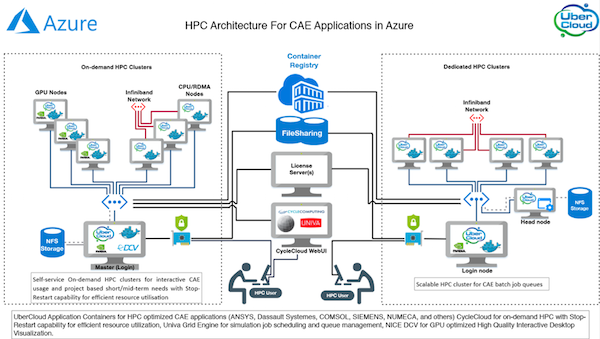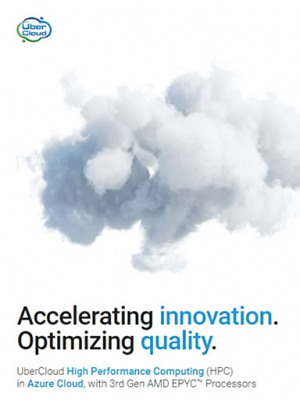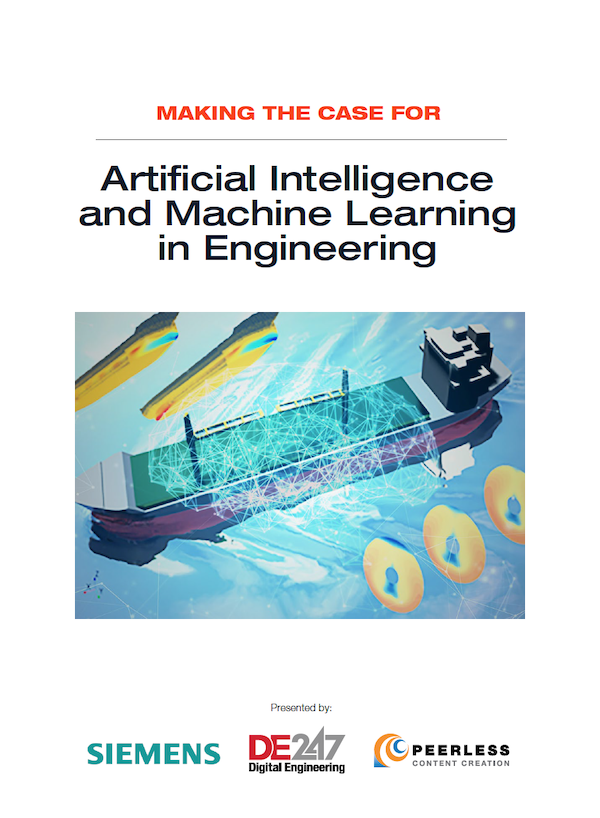
Figure 2: HPC architecture for CAE applications in Azure, with UberCloud CAE containers, CycleCloud, Univa Grid Engine, and NICE DCV. Image courtesy of UberCloud.
Latest News
October 21, 2020
After FLSmidth approached UberCloud to evaluate whether the time was right to consider moving their engineering simulation workload to the Cloud, FLSmidth and UberCloud implemented several engineering simulations on Microsoft Azure. The UberCloud project team worked with FLSmidth’s IT Group and subject matter experts to design and configure FLSmidth’s Azure cloud environment for running Ansys software in an HPC configuration, to benchmark FLSmidth applications, and to understand engineering simulation usage of Cloud HPC resources and related workflows.
The following case study and several cloud related topics will be presented in detail in three Webinars for the Americas (Manufacturing, Oct. 27, Fig. 1), Europe and Middle East (Manufacturing, Oct. 28), and Asia (Energy/Mining, Oct. 29). For more information, go to the registration page.


FLSmidth Use Case
FLSmidth is a leading supplier of engineering, equipment and service solutions to customers in mining and cement industries, with more than 135 years of experience, with activities in more than 100 countries worldwide, 11.000+ employees with unique process knowledge about projects, products and services to meet their customers’ needs for technical innovations, digitalization and sustainable lifecycle management.
The FLSmidth engineering team, which is distributed between locations in Copenhagen, India, South Africa and Brazil, drafted a list of their actual requirements with a two-year roadmap of moving several simulation scenarios using Ansys CFX and ESSS Rocky to Azure. FLSmidth currently has its own on-premises Intel/HPE cluster with 512 cores and Infiniband FDR for its 20 habitual users. The plan was to increase its user base and upgrade the on-premises environment with cloud bursting for mission-critical applications in CFD (multi-phase, combustion) using Ansys CFX, Fluent, and Mechanical and STAR CCM+. In addition, the company is applying the discrete element method (DEM) to simulate granular and discontinuous materials with ESSS Rocky.
FLSmidth HPC Cluster in Azure
FLSmidth’s IT Team created the pilot cluster in FLSmidth’s Azure subscription, and established access for the UberCloud team. The pilot cluster has IP based firewall security to allow proper access and testing.
Based on FLSmidth project team’s decision, West Europe and Central India datacenters were identified as POC sites. The Azure West Europe Data Center is the main site for FLSmidth’s datacenter migration. India was chosen as the second site to provide regional HPC resources to eliminate their latency issues.
Based on FLSmidth IT requirements and engineering usage needs, UberCloud created a flexible global HPC Cluster Architecture (Fig. 2), which is able to handle different workloads and easily expands to other sites providing maximum flexibility and cost efficiency. The main site in West Europe was created with two cluster types; one dedicated 256 core cluster for batch jobs managed by Univa Grid Engine based on queues with different priorities, and on-demand HPC clusters are used for all extra workloads and additional simulations that require powerful compute resources.
Azure’s CycleCloud provides self-service cluster provisioning and management capability directly to engineers without adding any overhead to IT. UberCloud created custom web interfaces in CycleCloud to provide these on-demand resources to engineers based on FLSmidth’s consumption rules built into the system. The team created: resource groups; 1 TB centralized storage account for storing test cases and shared files; head node, compute nodes, visualization nodes; container registry as resource group; and a license server. Finally, resources in the India cluster were created.
Application: FLSmidth
One of FLSmidth’s major applications is the simulation of the JETFLEX kiln burner, which offers maximal flexibility for solid pulverized and alternative fuel firing, with a unique design utilizing fixed or rotatable rectangular jet air nozzles, see Fig. 3. Fast and easy shipping keeps initial costs low, while a common solid fuel channel reduces usage of cold fuel-conveying air.
The JETFLEX burner is a highly flexible kiln burner, designed to produce the best flame shape at lowest NOx emissions for various fuel types and operating conditions. It fires rotary kilns (‘ovens’) with pulverised coal or coke, oil, natural gas, or any mixture of these fuels. Alternative fuel firing of plastic chips, wood chips and sewage sludge can also occur through the same common fuel channel. The JETFLEX burner is available for any fuel combination and maximum capacity ranging from 10 to 250 MW, catering for even the largest of rotary kilns. The primary air supply to the kiln burner enables a flame momentum of 7 N/MW up to 11 N/MW.

FLSmidth offers two kiln burner models: The standard JETFLEX burner and the JETFLEX PLUS burner. The standard JETFLEX burner has no moving parts, offering easy operation and reliability as fewer parts are exposed to wear. The kiln burner flame shape or momentum is easily controlled by simple regulation of the primary air pressure and flow. If you find a series of optimum kiln burner settings work for you, these can be easily repeated. This improves plant production by enabling smooth transition between production qualities or fuels. For optimum combustion flexibility, JETFLEX PLUS burner offers superior combustion of cost-effective grade fuels, complete flame-forming control and increased fuel retention time. The two design features that characterise the JETFLEX PLUS burner model are rotatable jet air nozzles and a retractable centre pipe for alternative fuel firing. The concentric placement of the rotatable jet air nozzles enables high suspension of the fuel inside the flame. The swirler is the main mechanism for shaping the flame during start-up and daily operation.
Conclusion and Next Steps
During this project, FLSmidth’s engineering applications (Ansys Mechanical, Fluent, CFX, and Rocky DEM) were implemented in Azure HPC and tested in West Europe and Central India datacenters. FLSmidth’s engineering and IT workflows were analyzed to provide the best cloud environment for the engineering processes which also reduces the IT management overheads. Cloud HPC will allow FLSmidth engineers to use simulation applications and vast resources on demand allowing faster results and turnaround time while providing complete control and management to IT. Moving the complete engineering simulations to Azure will provide scalable infrastructure and by keeping data in Azure’s secure data centers will eliminate any delays of data transfer to local systems.
As the result of this project, the HPC Cloud architecture was built and tested successfully. An Enterprise Roll-Out map was created identifying the steps necessary to establish steady-state operation. The next phase will focus on the Enterprise Roll-Out tasks and help FLSmidth complete its cloud migration of the HPC workloads.
More UberCloud Coverage

Subscribe to our FREE magazine, FREE email newsletters or both!
Latest News







